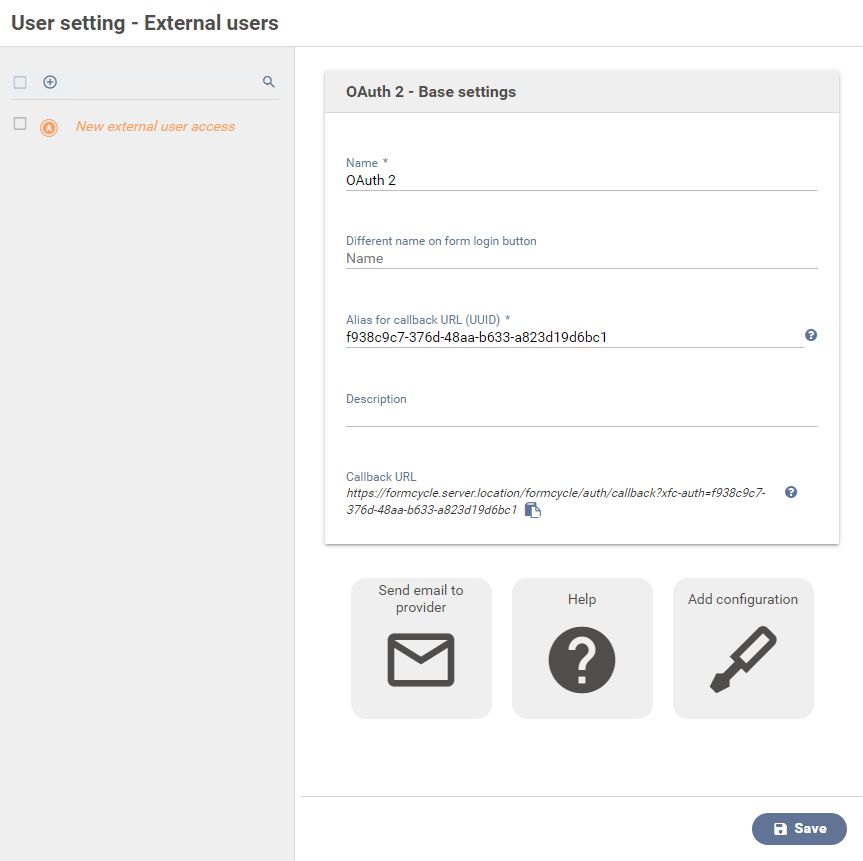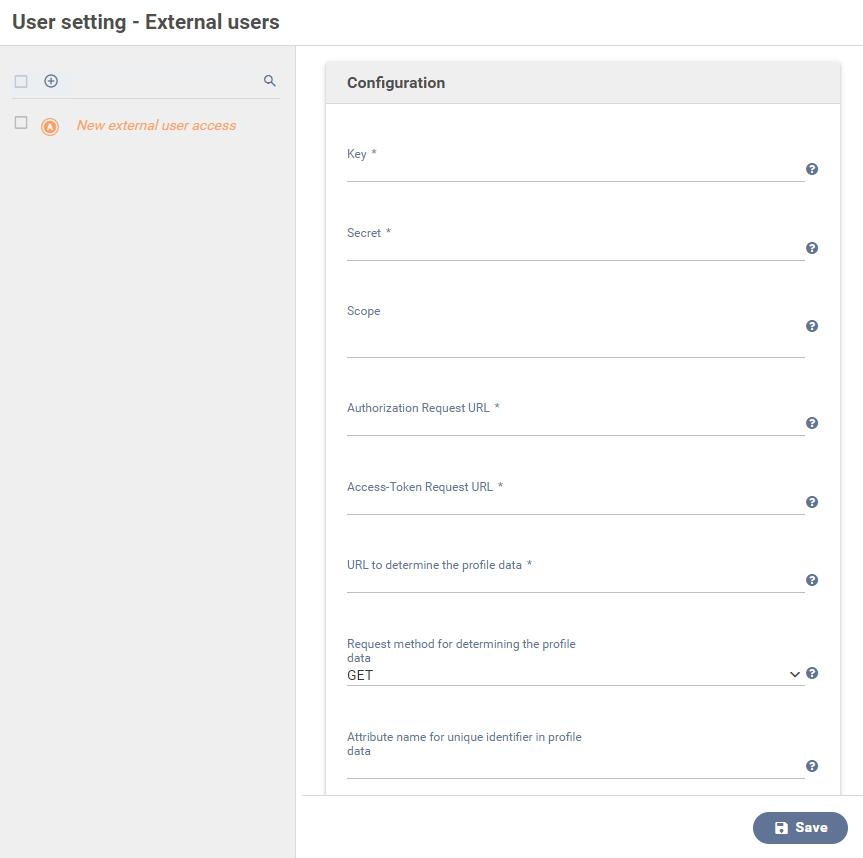OAuth 2
Auf der Oberfläche zur Konfiguration eines dem OAuth 2-Standard folgenden Identity Providers werden die folgenden Parameter abgefragt:
Grundeinstellungen
Name
Bezeichnung des Identity Providers in Xima® Formcycle.
Abweichender Name auf dem Login-Button des Formulars
Wenn ein Formular so konfiguriert wurde, dass mehrere Authenthentifizierungsmöglichkeiten zur Auswahl stehen, wird beim Öffnen des Formulars ein Dialog angezeigt in dem man eine Authentifizierungsart wählen muss. Hier kann festgelegt werden, welcher Textinhalt auf dem Button für diesen Identity Provider stehen soll.
Wird an dieser Stelle nichts eingetragen, wird die unter Name eingetragene Bezeichung verwendet.
Alias für Callback-URL (UUID)
Eindeutiger Identifikator, welcher der Identity Provider beim Rücksprung zu Xima® Formcycle verwendet. Dieser Wert wird automatisch generiert, kann bei Bedarf jedoch geändert werden.
Callback-URL
Die beim Rücksprung vom Identity Provider zu FORMYCYLE verwendete URL wird hier angezeigt und kann über das Kopieren-Symbol rechts neben der URL in die Zwischenablage kopiert werden. Falls Frontend-Server vorhanden sind, wird auch für diese die entsprechende URL angezeigt.
Initial sichtbare Schaltflächen
Unter den Grundeinstellungen befinden sich zunächst 3 Schaltflächen, deren Funktionen bei der Konfiguration des Identity Providers helfen sollen.
E-Mail an Provider senden
Öffnet das im System eingerichtete E-Mail-Programm mit einer vorformulierten Anfrage bezüglich der für die Konfiguration des Identity Providers im Xima® Formcycle benötigten Informationen.
Hilfe
Öffnet diese Hilfeseite im Browser.
Konfiguration hinzufügen
Nachdem die benötigten Informationen vom Identitiy Provider bereitgestellt wurden, kann durch einen Klick auf diesen Button der Bereich für die Konfiguration des Identity Providers geöffnet werden. Es öffnet sich der im folgenden beschriebene Bereich Konfiguration.
Configuration
Key
Unique ID of the configuration you get from your identity provider.
Secret
Secret key which is used to authenticate your client.
Scope
Specifies the access scope that FORMCYCLE uses when querying fields from the identity provider.
Authorization Request URL
Defines the URL which is used for an authorization request from the identity provider.
Access-Token Request URL
Defines the URL that is used to request the access token from the identity provider.
URL to determine the profile data
Defines the URL which is used to request the (user) profile data from the identity provider.
Request method for determining the profile data
Defines the request method (GET or POST) which is used for the request to receive the profile data from the Identity Provider.
Attribute name for unique identifier in profile data
Overrides the attribute name for the identifier in the returned profile data. The default value is "id".
Mapping of the profile attributes to FORMCYCLE user profile
Given name
Specifies which profile attribute should be used for the user's first name.
Last name
Specifies which profile attribute should be used for the user's last name.
Display name
Specifies which profile attribute should be used for the user's display name.
Username
Specifies which profile attribute should be used for the user name of the user.
Specifies which profile attribute should be used for the user's email address.
Language
Specifies which profile attribute should be used for the user's language. (Value must correspond to a code from ISO standards 3166 or 639.)
Location
Specifies which profile attribute should be used for the user's location. (Value must correspond to a code from ISO standards 3166 or 639.)
Picture URL
Specifies which profile attribute should be used for the user's picture URL. (Value must be convertible to a valid URI.)
Profile URL
Specifies which profile attribute should be used for the user's profile URL. (Value must be convertible to a valid URI.)
Extended attribute mapping
In addition to the ones listed above, other attributes can be defined in this table. A property and a corresponding value must be entered in each line.



